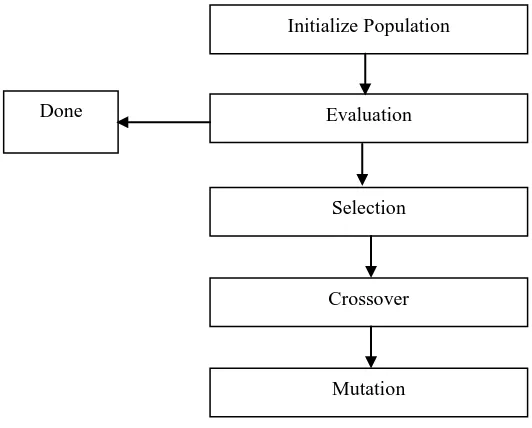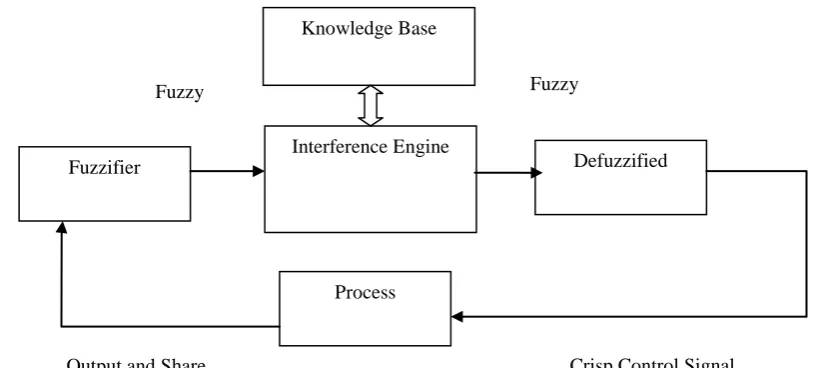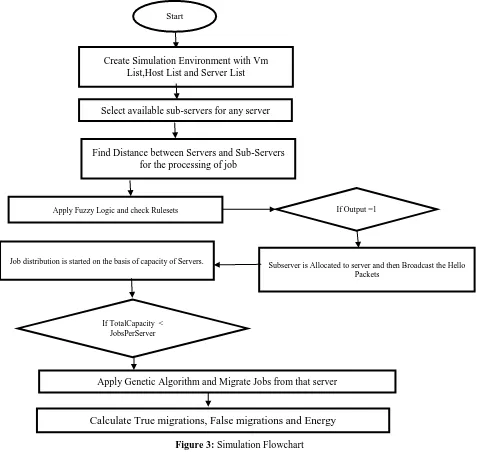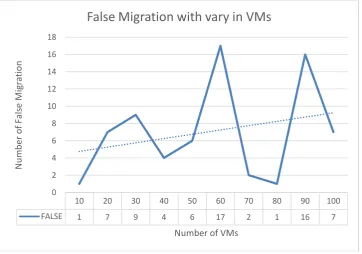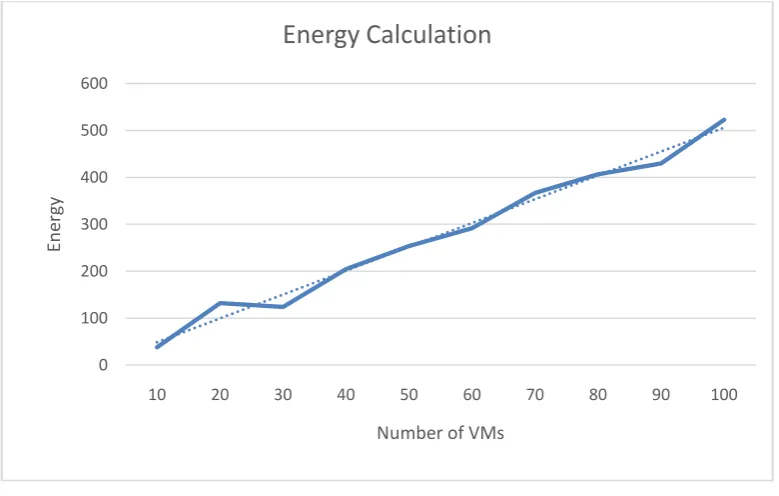International Journal of Advanced Trends in
Computer Applications
www.ijatca.com
Improved Energy Efficient Job Scheduling in Cloud
Computing
1
Simranjeet Kaur, 2Dr. Rajan Manro, 3Er. Robin Khurana
1Student(M.phil), 2Professor,3Assistant Professor 1,2Department of Computer Science and Engineering
DeshBhagat University, MandiGobindgarh, India 3
Assistant Professor,
Chandigarh Group of colleges, Landran(Mohali)
Abstract:
Cloud computing has offered services related to utility aligned IT services. Reducing the schedule length is considered as one of the significant QoS need of the cloud provider for the satisfaction of budget constraints of an application. Task scheduling in a parallel environment is one of the NP problems, which deals with the optimal assignment of a task. To deal with the favorable assignment of some task, task scheduling is considered as one of the NP problem. In this research work the jobs are distributed in a centralized environment. In Centralized environment every job request is forwarded to a central server. The central server passed the jobs to sub servers that are present with in the area of request. This has been performed by using distance formula. Also to reduce the energy consumption by each sub-server is possible by using formation of feedback queue. Job scheduling has been optimized on the basis of priority by using genetic algorithm. Rules are set according to the priorities of the job then scheduling is done by using genetic algorithm. Fuzzy logic also used for classification of the jobs to decide which job has been allotted to the system. Metrics namely, SLR, CCR (Computation Cost Ratio) and Energy consumption are used for the evaluation of the proposed work. All the simulations will be carried out in CLOUDSIM environment.Keywords:
CLOUDSIM, Computation cost ratio (CCR), Genetic algorithm (GA), SLR, energy consumption, Fuzzy logic.I.
INTRODUCTION
Cloud Computing is an innovation technology which utilizes mainly internet along with centralized remote-servers to keep data as well as applications. The idea of cloud computing is established on a basic principal of “re-usability of Information Technology capabilities”. The difference that cloud computing brings is compared to the traditional concepts of “grid computing”, “utility computing”, “autonomic computing” or “distributed computing”, and broaden horizons across organizational boundaries. Through virtualization, cloud computing is capable to address with the same type of physical infra-structure with dissimilar computational requirements. In cloud computing, Job scheduling is a time based approach in which maximum number of jobs should be executed in a given interval of time. The main problem which is often faced is managing the jobs in appropriate fashion so that they can be executed on time. Cloud network is not expensive; hence memory management also adds a
cost monitoring factor in order to avoid extra cost. The problem of this research work is organised in three sections. The problem of this research work also includes the distribution of the jobs in centralized environment. Centralized environment refers to a network in which each request ends to a central server. Then, the central server looks for the sub servers present in area from where the request has come. The search is based on distance formula mentioned below
𝐷𝑖𝑠𝑡 = (𝑥2 − 𝑥1)^2 + ( 𝑦2 − 𝑦1)^2
1) Organization of cloud environment. 2) Organizing responses according to jobs 3) Define the rule sets according to the priority 4) Job scheduling and VM migration using Genetic Algorithm
The evaluation will be done on the basis of the following parameters
a) Number of jobs executed in a given time span b) Total energy consumed in order to execute the jobs
c) Resource Utilization and VM is- utilization Objectives and Methodology
In the proposed research work, Genetic algorithm is used for optimization and Fuzzy logic is used for classifying the optimized results of the network.
GA (Genetic Algorithm) is basically utilized in the applications where the search space is large. The advantage of a Genetic Algorithm is that the procedure is fully automatic and avoids local minima. The major components of Genetic Algorithm are named as crossover, mutation, and a fitness function. The
crossover operations are utilized for generating a novel chromosome from parents sets while the mutation operators add variation. The fitness function executes a chromosome dependent on the criteria already defined. An improved fitness value of a chromosome increases its survival chance. The population is a chromosomes collection. A novel population is carried out by utilizing standard genetic operations like single-point crossover, mutation, and selection operator [52].
Step 1: To initialize random population having chromosomes.
Step 2: To calculate fitness function in the population.
Step 3: To develop novel population with individuals.
Step 4: To select parent chromosomes for best fitness function.
Step 5: To perform crossover to have copy of parents.
Step 6: To perform mutation to mutate novel off springs.
Step 7: To place novel offspring in the population.
Step 8: To repeat the steps to get a satisfied solution. Step 9: Stop.
Figure 1: Genetic algorithm flowchart
Fuzzy logic is based on the standard form of right or wrong, realism rather than modern computers based (1 or 0)
Boolean logic calculations. Natural language (like most other life activities or even the universe) is not readily converted to the absolute value of 0 and 1. This can be useful as a way to see the fuzzy logic inference real job, binary or Boolean logic is a special case. Fuzzy logic as 0 and 1, includes an extreme case of truth (or 'state of things' or 'truth'), but also includes a variety of real estate in the middle, so that, for example, the comparison results between the two things cannot be „high or 'short‟, but „high‟. Fuzzy logic works as the
human brain works. Fuzzy logic is for the development of human capabilities with AI (Artificial Intelligence) requirements and generates the representation of human cognitive abilities in software. The fuzzy logic implements on the possibilities level of input for achieving the desired output. Fuzzy Logic is applicable for practical and commercial purposes as defined below:
It might not provide exact reasoning but suitable reasoning.
Initialize Population
Evaluation
Selection
Crossover
It controls consumer and machine products. It helps for some uncertainty in engineering.
Figure 2: Fuzzy controller architecture
II.
L
ITERATURE SURVEYA comprehensive survey has been given related to various job scheduling techniques, like, Genetic algorithm and fuzzy logic algorithms.
Abdul Razaque et.al [2016], proposed a task scheduling algorithm using a non-linear programming model for separable task scheduling that assigns the correct number of tasks to each virtual machine. Based on this assignment, an algorithm for separable load scheduling is designed by considering the network bandwidth.
Dr. Amit Agarwal et.al [2014], proposed Generalized Priorities. The algorithm was used to effectively perform tasks and Comparison with FCFS and Round Robin Scheduling. The algorithm was simulated in the cloud Sim Toolkit and the results show that it provides better performance compared to other traditional scheduling algorithms.
Jichao Hu et.al [2015], proposed resources in the cloud model and predicts the effect of the model time closer to the actual time. It could effectively limit the possibility of falling into the local convergence and shorten the time of the optimal solution of the objective function value, and more satisfy the user's needs.
Raja Manish Singh et.al [2014], proposed different algorithms that were compared and studied Adaptability, feasibility, adaptability in the context of the cloudSim, after which the author is tried to propose a hybrid approach can be used to further strengthen the existing platform and so on. It can help cloud providers to provide better quality of the service.
VahidAshktorab, Seyed Reza Taghizadeh [ 2012]
has discussed the advantages of the cloud platform and the security risks of keeping the data on a cloud server. In this research, author have provided basic information
about the security thefts of cloud server like SQL injection problem , DOS attacks and others.
Tao Lin et al. [ 2017] proposed an iterative algorithm for solving the problem of multi-objective optimization. Authors adopted a Game Theoretical approach for managing the data traffic so that energy can be optimized. Authors worked with transport layer to form an energy efficient framework in cloud computing.
Jiayang et.al [2011], has proposed an adaptive resource allocation algorithm for the cloud system with pre-empt able tasks in which algorithms adjust the resource allocation adaptively based on the updated of the actual task executions. In this paper, author has presented two algorithms i.e. Adaptive list scheduling (ALS), Adaptive Min-min scheduling (AMMS).
Gouzardi et.al [2010], has solved resource allocation problem using SLA violations. In this, the upper bound of total profit is provided with the help of force-directed resource assignment (FRA) heuristic algorithm, in which initial solution is based on providing the better solution for profit upper bound problem.
III.
SIMULATION MODEL
The simulation environment is created using Cloudsim environment in Net Beans. The number of virtual machines, Servers and Sub Servers are created with their initial properties. The Servers availability has been checked for Sub Servers to check the allocation of the tasks.
Knowledge Base
Interference Engine
Fuzzifier Defuzzified
Process
Output and Share Crisp Control Signal
Figure 3: Simulation Flowchart
The distance between available Servers and Sub Servers is being found out. The processing is done of Fuzzy Logic and rule sets are applied on the List of tasks and Virtual machines. The virtual machines are implied on the sub servers. So, after checking the rule sets if output is 1 then tasks are allocated to virtual machines. Then the Capacity of the Servers is being checked. The capacity of server is exceeded after allocation of tasks then the problem of Load balancing is occurred. To solve the load balancing problem, the tasks are migrated to other virtual machines or sub servers. Then the Genetic algorithm is applied.
The methodology is described in steps:
Step 1: Start and design the simulation work frame in CloudSim Environment with CPU, Memory and Disk Properties.
Step 2: Firstly, we Initialize VM and set their properties.
Step 3: After that, Initialize Hosts and define features for the Host
Step 4: For each VM in the allocation table at each host, Apply Neural Network Approach.
Step 5: To apply genetic Algorithm for Virtual Machine Migration if Load on Host exceed from its capacity.
Step 6: Evaluate the performance metrics.
Step 7: Stop
IV.
SIMULATION RESULTS
The results are executed in CLOUDSIM Environment. The Number of Virtual Machines is varying during Input so different iterations are calculated. The Servers are same for all the processes. The Results are based on Number of Migrations and Energy.
Subserver is Allocated to server and then Broadcast the Hello Packets
Start
Create Simulation Environment with Vm List,Host List and Server List
Find Distance between Servers and Sub-Servers for the processing of job
Select available sub-servers for any server
Apply Fuzzy Logic and check Rulesets If Output =1
Job distribution is started on the basis of capacity of Servers.
If TotalCapacity < JobsPerServer
Apply Genetic Algorithm and Migrate Jobs from that server
Table 1: Results calculation with different number of Virtual Machines
NUMBER OF VMS FALSE MIGRATION TRUE MIGRATION ENERGY
10 1 8 38
20 7 22 132
30 9 30 124
40 4 45 205
50 6 56 254
60 17 52 292
70 2 67 367
80 1 78 407
90 16 63 430
100 7 92 523
The above Table defines all the Migrations with False and True Rate. The Energy is also calculated during this process. The Number of Virtual Machines is varying from 10 to 100. These Virtual machines are situated on sub servers and have multiple tasks that are allocated on them. During this research, the load
balancing problem is solved by migrated Virtual Machines from Sub Servers. The above results are calculated after 10 iterations.
Figure 4: False Migrations during Task allocation
The above Figure shows the number of False Migration during migration process when Load is balanced on servers. The Trendline explains shows that the number
of false migrations are incremented with increase in number of Virtual machines on Servers.
10 20 30 40 50 60 70 80 90 100
FALSE 1 7 9 4 6 17 2 1 16 7
0 2 4 6 8 10 12 14 16 18
N
u
m
b
er
o
f Fa
ls
e
Migrat
ion
Number of VMs
Figure 5: True Migration during Task Allocation
The above defines the Number of True Migrations during the working of thesis. The results show that the numbers of
True Migrations are incremented with increment in Number of Virtual Machines within a network.
Figure 6: Energy Consumption during Task Allocation process
The Energy Calculation results are shown in above Figure. The Trend line shows that the Energy
Consumption is more when the numbers of virtual machines are incremented within any Network.
V.
CONCLUSION
Fuzzy logic for task scheduling in cloud computing. Genetic algorithm has been used for analyzing the number of jobs according to their execution time, cost,
SLR etc. Then the analyzed jobs are scheduled or selected by using Fuzzy logic. The main aim to use fuzzy logic algorithm is to investigate the priority of a job that must be executed first. Secondly fuzzy logic has been used to adapt priorities of other jobs being waiting in case of new jobs arrives and considering deadlines for this jobs.Jobs having little processing time are assigned new higher processing priorities and hence improving user satisfaction.
10 20 30 40 50 60 70 80 90 100
TRUE 8 22 30 45 56 52 67 78 63 92
0 10 20 30 40 50 60 70 80 90 100
N
u
m
b
er
o
f Tru
e
Migrat
ion
s
Number of VMs
True Migrations varying with number of VMs
0 100 200 300 400 500 600
10 20 30 40 50 60 70 80 90 100
En
ergy
Number of VMs
The parallel machine scheduling problem receives considerable attention in both academic and industrial fields. Various factors involved in scheduling problems are often imprecise or uncertain. The fuzzy set theory provides a convenient alternative framework for modelling real-world systems mathematically and offers several advantages in the use of heuristic approaches. In this study, the parallel machine scheduling problem with GA is considered and a Fuzzy rule set is used to allocate tasks on virtual machines. The load balancing problem is also solved in this approach by migrating number of virtual machines. The resulted parameters are calculated at the last to check the optimization. In future, other algorithms like ACO, ABC, and Firefly are applied on the same approach for better results.
REFERENCES
[1] Youwei Ding, Xiaolin Qin, Liang Liu, Taochun Wang, “Energy efficient scheduling of virtual machines in cloud with deadline constraint”, Science Direct 2015.
[2] Q. Li and Y. Guo, “Optimization of Resource Scheduling in Cloud Computing,” 2010 12th International Symposium on Symbolic and Numeric Algorithms for Scientific Computing, Timisoara, 2010, pp. 315-320.
[3] X. Lin, Y. Wang, Q. Xie and M. Pedram, “Task Scheduling with Dynamic Voltage and Frequency Scaling for Energy Minimization in the Mobile Cloud Computing Environment,” in IEEE Transactions on Services Computing, vol. 8, no. 2, pp. 175-186, March-April 1 2015.
[4] Y. Li, M. Chen, W. Dai and M. Qiu, “Energy Optimization With Dynamic Task Scheduling Mobile Cloud Computing,” in IEEE Systems Journal, vol. 11, no. 1, pp. 96-105, March 2017.
[5] Z. Zhong, K. Chen, X. Zhai and S. Zhou, “Virtual machine-based task scheduling algorithm in a cloud computing environment,” in Tsinghua Science and Technology, vol. 21, no. 6, pp. 660-667, Dec. 2016.
[6] X. Xu, L. Cao, X. Wang, X. Xu, L. Cao and X. Wang, “Resource pre-allocation algorithms for low-energy task scheduling of cloud computing,” in Journal of Systems Engineering and Electronics, vol. 27, no. 2, pp. 457-469, April 20 2016
[7] Abdul Razaque, Nikhileshwara Reddy Vennapusa, “Task Scheduling in Cloud Computing”,IEEE2016.
[8] Dr. Amit Agarwal, “Efficient Optimal Algorithm of Task Scheduling in Cloud Computing Environment”,
International Journal of Computer Trends and Technology (IJCTT) – volume 9 number 7– Mar 2014.
[9] Jichao Hu, “Task Scheduling Model of Cloud Computing based on Firefly Algorithm” International Journal of Hybrid Information Technology Vol.8, No.8 (2015), pp.35-46.
[10] Raja Manish Singh, “Task Scheduling in Cloud Computing: Review,” International Journal of Computer Science and Information Technologies, Vol. 5 (6) , 2014, 7940-7944.
[11] VahidAshktorab, Seyed Reza Taghizadeh (2012), “Security Threats and Countermeasures inCloud Computing”,International Journal of Application or Innovation in Engineering & Management (IJAIEM).
[12] T. Lin, T. Alpcan and K. Hinton, “A Game-Theoretic Analysis of Energy Efficiency and Performance for Cloud Computing in Communication Networks,” in IEEE Systems Journal, vol. 11, no. 2, pp. 649-660, June 2017.
[13] Jiayin Li, Meikang Qiu, Jian-Wei Niu, Yu Chen, Zhong Ming, “Adaptive Resource Allocation for Preempt able Jobs in Cloud Systems,” in 10th International Conference on Intelligent System Design and Application, Jan. 2011, pp. 31-36.
